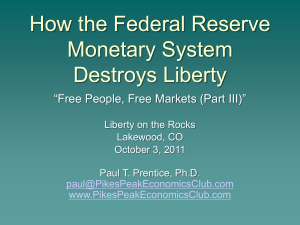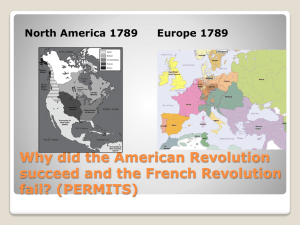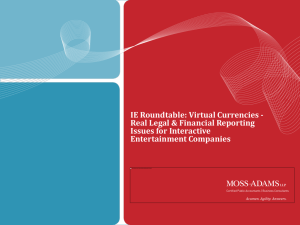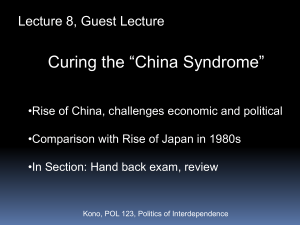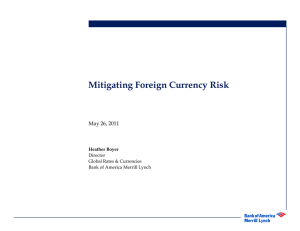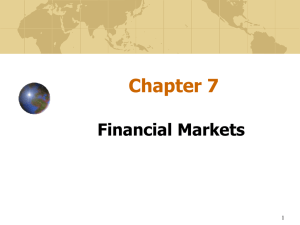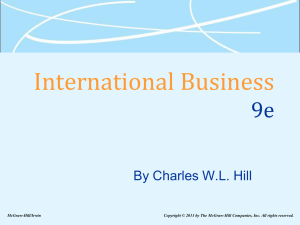Mercantilism - James Ashley Morrison
advertisement
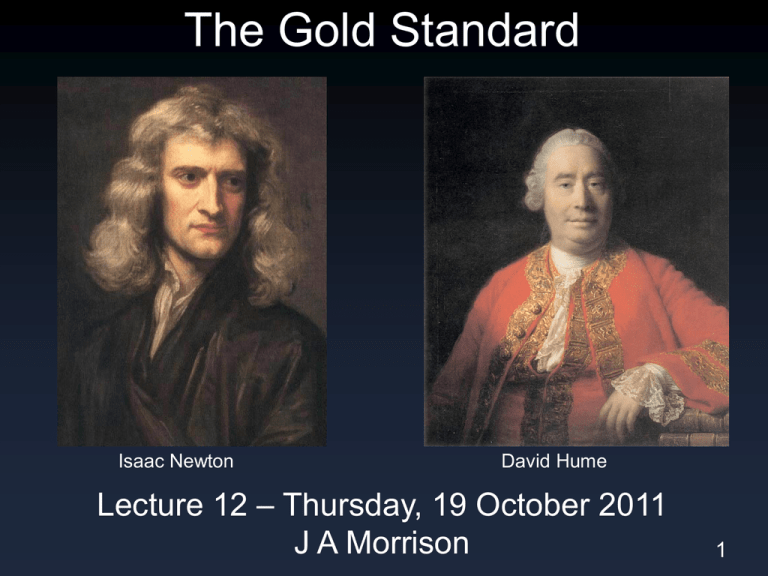
The Gold Standard Isaac Newton David Hume Lecture 12 – Thursday, 19 October 2011 J A Morrison 1 Lec 12: The Gold Standard I. Intro: Why bother with Gold? II. The Gold Standard as an Ideal Type III.Breaking the “Rules of the Game” IV.Brief History of the International Gold Standard V. Conclusion 3 Lec 12: The Gold Standard I. Intro: Why bother with Gold? II. The Gold Standard as an Ideal Type III.Breaking the “Rules of the Game” IV.Brief History of the International Gold Standard V. Conclusion 4 Historical Significance • Provides insight into most of monetary history • Integral to First Era of Globalization • Enduring legacies in contemporary system – International Monetary Fund – Distribution of worldwide gold supply 5 Intellectual Significance • Robust alternative to current system of floating ERs • Lessons from First Era of Globalization • Parallels with current crises – China’s “dirty float” – Constraints and opportunities generated by currency union (e.g. Euro) 6 Lec 12: The Gold Standard I. Intro: Why bother with Gold? II. The Gold Standard as an Ideal Type • Breaking the “Rules of the Game” • Brief History of the International Gold Standard • Conclusion 7 II. THE GOLD STANDARD AS AN IDEAL TYPE 1. The Gold Standard Rules 2. Purchasing Power Parity 3. The Automaticity of the Gold Standard Remember our understanding of an exchange rate: the valuation between the domestic currency and foreign currency/currencies. 9 In theory, the gold standard (GS) was an exchange rate regime that related the member countries’ currencies through their valuations to gold. 10 Gold as an Intermediary $ £ ¥ € Example: £1 = 1 oz gold = $4.86 11 II. THE GOLD STANDARD AS AN IDEAL TYPE 1. The Gold Standard Rules 2. Purchasing Power Parity • The Automaticity of the Gold Standard The gold standard ideal was that all currencies would be freely convertible through gold. This would secure purchasing power parity (PPP). And PPP would ensure complete market integration. 19 Purchasing Power Parity (PPP) • Purchasing power (PP): command over goods and services – $919.50 = 1 oz gold – £639.43 = 1 oz gold • PPP: money enjoys the same purchasing power in every market even after making necessary conversions – Implied PPP (based on gold prices): $1 = £0.695 • PPP can be calculated using any “basket” of goods & services 20 PPP versus Market Rates • Implied PPP (from gold prices): $1 = £0.695 • If I can trade $1 for £0.695, I should be able to buy gold at the same “price” in GB and in the US • BUT Market Exchange Rate: $1 = £0.691 Why the difference? Why doesn’t arbitrage eliminate the difference? 21 Let’s go through an example… 22 $499 £429 23 But the market ER is $1 = £0.63 So, $499 = £314 Yet...iPads cost £429 in London! That’s over £100 more! Why don’t the Brits just buy their iPads here? 24 25 Well, some do buy them here! But, for many, the costs are greater than just buying it in London. 26 Valuation • Valuation: the relationship between market price and underlying “value” • Different ways to calculate valuation – Stock: price-to-earnings-to-growth (PEG) ratio – Currency: PP versus ER • Over and Under – Overvalued: currency purchases less than ER implies (PP < ER) – Undervalued: currency purchases more than ER implies (PP > ER) 27 II. THE GOLD STANDARD AS AN IDEAL TYPE 1. The Gold Standard Rules 2. Purchasing Power Parity 3. The Automaticity of the Gold Standard The GS was meant to automatically ensure both the quantity of money in the world and the distribution of money around the world. 29 GS Regulation of Quantity • Official/Mint Price: price of gold in terms of local currency • Free Conversion: monetary authority should… – Purchase gold with currency at the official price – Sell gold for currency at the official price • Automatic Quantity Adjustment – Overvalued currency sell currency for gold decrease in currency and increase of gold – Undervalued currency sell gold for currency increase in currency and decrease in gold • Sustained increases in gold price mining 30 By regulating the quantity of currency automatically, adherence to the GS would theoretically ensure domestic price stability. After all, if the official ER did not match the PPP, currency/gold would be converted. 31 What about the distribution of gold? Who gets how much gold? 32 GS Regulation of Distribution • David Hume’s Price-Specie-Flow Model • Assume: costless int’l transport & conversion Excess Gold in US Rise in US Prices US Prices Fall; BoT Equilibrates US Imports Increase; Exports Decrease US Exports Gold 33 Despite these advantages, policymakers have frequently found it in their interest to bend the “rules of the gold standard game”… 34 Lec 12: The Gold Standard I. Intro: Why bother with Gold? II. The Gold Standard as an Ideal Type III.Breaking the “Rules of the Game” • Brief History of the International Gold Standard • Conclusion 35 As a formal matter, being on the GS required two things: (1) maintain exchange rate stability (“gold parity”); (2) maintain convertibility between domestic currency gold... 12 (1) Maintain Exchange Rate Stability (“gold parity”) --> the monetary authority commits to doing everything in its power to ensure that the market ER with gold remains at the predetermined, official “parity.” 12 (2) Maintain Convertibility between Domestic Currency & Gold. --> No restrictions on the purchase/sale of domestic currency/gold. No restrictions on the import/export of gold or currency. But remember the balance of payments constraint. States only have a few ways to reconcile imbalances of payments... Remember this slide? Lecture 6: Balance of Payments (Slide #38) 38 Following the gold standard rules precludes two… 41 Reconciling the BoP under the Gold Standard 1. Adjustment of Reserves 2. Adjustment of Internal Prices & Incomes 3. Exchange Rate (ER) Adjustment 4. Exchange Controls 1. Capital Controls: Limit convertibility 2. Commercial Policy 15 Bracketing option 1 (adjusting reserves), states face a difficult choice between: (2) allow price-specie-flow to dictate changes in domestic macroeconomic conditions; (4.2) use commercial policy (tariffs, subsidies, &c.) 40 These are the “golden fetters” that have put policymakers in a “golden straightjacket.” 41 But why can’t they just adjust reserves? 42 Remember the asymmetric positions of deficit and surplus countries: Surplus countries can accumulate reserves ad infinitum. While deficit countries will eventually exhaust their reserves. 42 IV. BREAKING THE RULES OF THE GAME 1. Deficit Countries 2. Surplus Countries Deficit countries have frequently violated the two formal “rules of the gold standard game.” 44 Exchange Rate Adjustment • Specie: Change quantity of precious metal in coins • Backed currency: Adjustment of official exchange rate • Fixed fiat currency: Shift in “target” market rate 45 Limitations on Convertibility • Restrictions on market exchange, foreign investment, and import/export of currency (e.g. China today) • Government imposed costs on conversion – Fees to convert currency via monetary authority – Restrictions on conversion (e.g. delay at the mint) 46 – Tax on capital movement (e.g. Tobin tax) IV. BREAKING THE RULES OF THE GAME 1. Deficit Countries 2. Surplus Countries Sterilized Intervention • Intervention: government maintains stable market ER by selling domestic currency in exchange for foreign currency – Foreign currency is then held in reserve • Sterilization: government counters inflation by buying excess domestic currency with government debt (open market operations) • Sterilized Intervention: intervention + sterilization 49 The result is that the exchange rate remains stable, domestic prices and incomes remain stable, and the government simply amasses foreign reserves. This saves the surplus country from having to adjust today. It also provides reserves for a “rainy day” in the future. 50 Surplus Countries under the The sky is the limit! Gold Standard Inflation countered by sterilization 1. Adjustment of Reserves 2. Adjustment of Internal Prices & Incomes 3. Exchange Rate (ER) Adjustment Maintained through intervention 4. Exchange Controls 1. Capital Controls: Limit convertibility 2. Commercial Policy 51 But it also shifts the burden of adjustment entirely onto the shoulders of the deficit country. And it creates competition for reserves. 52 This is what the US and France did in the 1920s. And this is largely what China is doing today. 53 Lec 12: The Gold Standard I. Intro: Why bother with Gold? II. The Gold Standard as an Ideal Type III.Breaking the “Rules of the Game” IV.Brief History of the International Gold Standard • Conclusion 54 Here are a few of the highlights of the emergence and ascent of the international GS. 55 56 Britain Adopts the “Silver Standard” • 1696: Locke convinces Parliament to adopt silver standard – permanently fixed – Fully convertible units into specified amounts of metal • Locke combated bimetallism – “Silver is the instrument and measure of Commerce in all the Civilized and Trading parts of the world.” (374) – Let gold float vis-à-vis silver; no official exchange rate between gold & silver 57 From Silver to Gold • 1717: Newton overvalues gold vis-à-vis silver – Gresham’s Law: overvalued gold drives out undervalued silver – Britain is on de facto gold standard • 1819-1821: Ricardo convinces Britain to adopt de jure gold standard – Exchange rate stability: return to pre-war parity! – Convertibility: no limits on convertibility Throughout, Britain maintained a robust commitment to a metallic standard. All that changed was the metal. 58 59 The US: Hamilton versus Jefferson • Hamilton’s Reports – Report on a National Bank (1790) – Report on the Mint (1791) – Report on Manufactures (1791) • Hamilton: Banks & Paper Money – Stimulate domestic industry – Reduce dependence on foreign trade & capital – Court financial interest political stability • Jefferson: Specie & International Integration – Market integration efficiency & peace – Suspicion of financial interest: banks & corruption – Insulation Southern dependence on North 60 US Monetary Policy • 1791: First Bank of the United States – Triggered Constitutional debate on Art 1, Sec 8: “Necessary & Proper” Clause – Bank issues extensive token/paper currency, heavily leveraged • 1792: US Mint Act – Bimetallism – Hamilton says, “What the hell: we’ll have some specie too!” 61 My Assessment • Hamilton was lazy – Did not bother with important technical details – Just copied Britain • But he had political savvy – Won public debate by citing British example – Got backing of powerful financial elites – Had Washington’s ear • Jefferson was a philosopher – Better understanding of technical details – But too abstract and reactionary for public – Did not build a coalition in time 62 Maggie and Me at the First Bank of the United States in Philadelphia 63 64 France • Nominally bimetallic • But traditionally a silver country • 1840s: gold discoveries overvalued gold de facto gold standard 65 66 Setting the Standard • 1867: Paris conference to officially appoint gold as int’l standard • Conference wasn’t legally successful, but inspired trend • 1870s – Germany moves toward gold – France attempts to undercut Germany by attracting gold bimetallic block busts • 1879: US goes to gold; Japan follows • Network Effect: value of being on common standard increases as membership 67 Lec 12: The Gold Standard I. Intro: Why bother with Gold? II. The Gold Standard as an Ideal Type III.Breaking the “Rules of the Game” IV.Brief History of the International Gold Standard V. Conclusion 68 The gold standard certainly seems dated. None of us had been born when the international gold standard system collapsed in the 1970s. But there are good reasons to understand it… 69 Importance of Gold • Era of fiat currency (1971-present) is vast exception to rule; commodity currency has been norm • Will the new era endure? – Nth Currency is a national currency – Can governments be trusted with fiat currency? • Key insights useful to new era – Emergence of capital controls in China – Challenges in EU: integration versus domestic policy autonomy 70 Essentials of Gold Standard “Era” • Few countries fully adhered to the “rules of the gold standard game” – Deficit countries violated formal rules: convertibility and ER stability – Surplus countries violated informal rules: amassed reserves • Level of adherence correlated with: – Closeness to London – Relative size of economy How might we explain this correlation? 71 Next time, we’ll discuss the decline and fall of the gold standard. This will allow us to examine the political dimensions of exchange rate regimes in a rich context. 72




